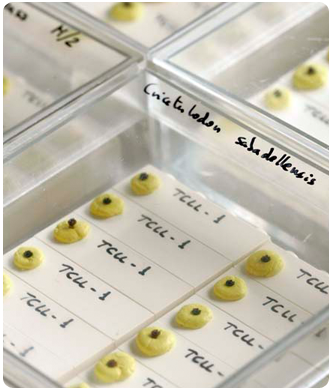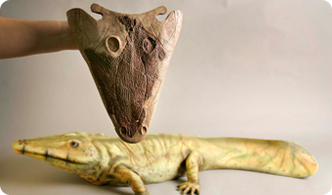How do the restorers work?

The restorers of the ICP are in charge of the proper preservation of fossils and contribute to finding different solutions to keeping them from becoming damaged from the time when they are extracted until their treatment in the laboratory.
The mission of the restorers is to maintain the physical properties and the persistence of chemical agents of fossils. That is to say, to avoid deterioration of the fossil. They are also in charge of repairing fossils if they are fractured when they are found in the deposit.
Why it is necessary to restore a fossil?
Restoring a fossil is important in order for it to remain in proper condition for being manipulated and investigated by the researchers or shown to the public. The fossil, once extracted from the deposits, experiences changes in temperature and humidity.
For proper conservation, it is of fundamental importance to avoid abrupt changes in these factors. Therefore, at the time of extraction, a good system of packing that guarantees suitable conditions for the fossils is essential in case there is a delay until it is prepared in the laboratory.
What are the stages of restoring a fossil?

As soon as the fossil arrives at the restoration laboratory the restorers open the 'mummy'. That is to say, they remove the fossil from the polyurethane or plaster wrapping that the paleontologists have made during the excavation of the deposit.
Immediately afterwards, the restorers separate the fossil from the matrix. This work can take weeks.
In the case of a broken fossil, it is necessary to repair it and to unite fragments, often with the collaboration of a researcher. This is in order to reconstruct the unit and to have it in its original condition.
The fossil is cleaned, and finally it is consolidated with chemical agents, so when the piece is needed for study it is in good condition.
Restoration work can be very complex. It depends in good measure upon the matrix that the fossil is adhered to. If, for example, this matrix is a material that easily fragments, the restorers will have to be very careful. Otherwise, if the matrix is a hard one, then it will be necessary to take care of separating and cleaning the fossil without damaging it.
How are the micro-vertebrate fossils prepared?

Obtaining micro-vertebrate fossils is carried out following a different methodology from the one used in the case of the macro-vertebrate.
In this case, the most important element is not the preservation and preparation of the remains, but rather to obtain a high number of remains. The technique varies remarkably from the one described in the previous section due to the small size of the elements that are usually recovered. In this case, to obtain the remains, it is necessary to select a concrete geologic level and to fill it with sediment coats of approximately 25 kg.
Later, this sediment is transferred to a set of buckets with water. The sediment must be soaked (minimum twenty-four hours), so that the clay softens.
Once this is done, the sediment, the mud and the water go through a set of sieves in order to retain the portion of sand measurement. Bones of reptiles, amphibians, birds, fish and teeth of small mammals can be found between this portion. All these remains are separated from the sandy part under a binocular microscope (called \"concentrated\" by the paleontologists), after having been previously dried.
Because of the fragility and size of treated fossils, the separation of fossil remains from the inorganic mineral material is carried out using precision clamps (microelectronics) that provide an optimal relation between pressure and precision.
The cleaning of the teeth or bony fragments passes through the treatment with weak acids or the application of ultrasounds. In either case, it is necessary to go carefully because an excess in the concentration of acid, the time of immersion or an inadequate product, can destroy the remains.
In the same way, for those fossils requiring ultrasound treatment, a few more seconds under the ultrasound can break fossils.
Making molds and copies

The constant manipulation of fossils by the researchers can damage the pieces, and on occasion these can be unique pieces.
In order to avoid spoiling the original ones, in the preparation laboratory molds and copies of the pieces are made. In this way, the researchers can recreate hypothesis, make reconstructions of the individuals, comparative studies, and exchange materials with other centers without putting the original ones in danger.
Sometimes molds are made in the deposits if a fossil, due to its location or nature, cannot be extracted, or simply because conservation of its state and original position before being extracted is needed. This can contribute to interesting information for its later study or exhibition.
Diclosure
Over the years of restoration work at the ICP laboratory, disclosure has become an important activity. It has been done through participation in congresses, publication of articles, doing practicums for students of restoration schools and open house days for the public.









